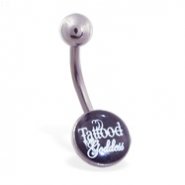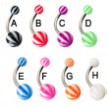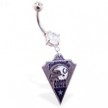Logo belly button ring "Tattooed Goddess"
- Length: 7/16" (11mm)
- Gauge (Thickness): 14 (1.6mm)
- Material: 316L surgical grade stainless steel
- Type: belly button ring
- -: 5mm top ball
- -: priced and sold individually
| Click on the picture to see a big picture and description of the body jewelry you are interested in. | |||||||||
|---|---|---|---|---|---|---|---|---|---|
|
14K Gold Bezel Set Pink Tourmaline...
$84.99
14K Gold Bezel Set Pink Tourmaline Belly Ring
|
Acrylic beach ball belly button ring
$1.98
Acrylic beach ball belly button ring
|
Belly Ring with dangling Pink and...
$7.99
Belly Ring with dangling Pink and Black Hollywood Star
|
Belly Ring with official licensed NFL...
$8.50
Belly Ring with official licensed NFL charm, Indianapolis Colts
Licensed and Official retailer of NFL- Indianapolis Colts Belly Button Ring. |
||||||
Stainless Steel
Of the many stainless steels available, only 316L or LVM is suitable for use as body jewelry. 316L is a low-carbon variety of 316. 316LVM is 316L, Vacuum Melted when manufactured. The low pressure prevents any air / airborne contaminants to attach to the molecules in the metal, resulting in a more consistent steel. For most people, however, that the steel be 316LVM is not a necessity to heal and maintain a healthy piercing.
The jewelry should be polished to a reflective shine (mirror-finish), free from rough edges, tool marks, wire-drawing lines and pitting which is present in the surface of the steel when it arrives from the mill. When polished, true 316L is a white, not grey, metal. Under-polishing will be most evident along the inside of the ring, where polishing is most difficult.
316L arrives from the steel manufacturer at specified degrees of hardness. Most jewelry manufacturers use the least-hard (1/4 hard) steel available for rings. Working the steel and forming the steel into rings hardens it to some degree. Annealing, a controlled heating and cooling process performed in a vacuum, yields a more flexible steel, resistant to metal fatigue. Most piercers and jewelry manufacturers agree that steel rings should be annealed to some degree after forming or formed from annealed wire, as an annealed ring is easier to safely and quickly manipulate for insertion; in the thinner gauges, pliers are often unnecessary.
On the other hand, some manufacturers feel that annealing the thinner gauges (18 through 14ga) makes the ring too malleable to maintain its shape and retain the bead. However, for most applications annealed rings are safe. For piercings subject to enough pressure to reshape the ring, a thicker gauge is advised. Depending on the gauge and diameter, annealing limits the minimum bead size which can be used (eg. a soft 14ga 5/8” ring would not securely hold a bead smaller than 7/32”).
The more a ring is annealed, the easier the finish is scratched from tools or simply from daily wear. The trade-off is that the harder rings require tools to manipulate, which increases the chance of damage during insertion. A non- annealed or close to full-hard ring will break under stress, when the ring is torqued open. Fractures invisible to the unaided eye may be created. These breaks can trap bacteria and lymph discharge and complicate the healing process.
The importance of manufacturing the barbell balls, their threads and ring beads of 316L has been questioned by some manufacturers and piercers, but it is the author9s opinion that any part of the jewelry in contact with the openings of the piercing or with bodily secretions should be of 316L or of one of the other metals suitable for use in piercings.
316L is classified as an austenitic steel. Austenitic steels are generally non magenetic when annealed, although some may become slightly magnetic by cold working.




